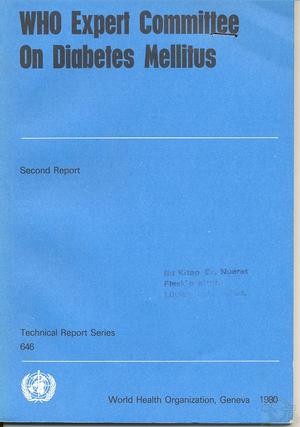Who Expert Committee On Diabetes Mellitus
İÇİNDEKİLERCONTENTS 1. Introduction 2. Definition, diagnosis and classification 2.1 Definition............. 2.2 Diagnosis and diagnostic criteria 2.3 Classification........... 3. Epidemiology................. 3.1 Natural history............. 3.2 Prevalence, incidence and risk factors 3.3 Mortality and cost of diabetes..... 3.4 Screening............... 4. Causes and mechanisms..................... 4.1 Natural history of the B cell................ 4.2 Genetic mechanisms and specific markers........ 4.3 Acquired and environmental factors ........... 4.4 Relationship between genetic and environmental factors 4.5 Metabolic and endocrine disturbances.......... 5. Management of diabetes..... 5.1 Food............ 5.2 Insulin............ 5.3 Oral hypoglycaemic agents 5.4 Other antidiabetic treatment 5.5 Resources required...... 5.6 Acute metabolic problems . 5.7 Other metabolic problems . 5.8 Pregnancy.......... 5.9 Surgery and the diabetic . . 5.10 Diabetes in children 5.11 Diabetes in the elderly . . . 6. Complications........... 6.1 Pathogenic processes..... 6.2 Suggested causal mechanisms6.3 Prevention of complications.......... 6.4 Diabetic complications of organs and systems 7. Health services for the diabetic............... 7.1 Primary health care................... 7.2 Diabetes care at the secondary level.......... 7.3 Diabetes care at the tertiary level: specialized services 7.4 The diabetic outpatient clinic............. 7.5 Major requirements of diabetics............ 8. The diabetic in society........ 8.1 Employment......... 8.2 Insurance and sickness benefit 8.3 Other social problems..... 8.4 Children with diabetes..... 8.5 The elderly........... 8.6 Nutrition........... 8.7 Drugs and equipment 9. Education.................. 9.1 Patients................ 9.2 The family............. . 9.3 Health care personnel........ 9.4 The community . . 9.5 Policy planners............ 9.6 Resources............... 9.7 The role of the various organizations 10. Research and future developments............ 10.1 Population studies.................. 10.2 Studies on the prevention of diabetes........ 10.3 Education....................... 10.4 Methods of treatment and assessment of diabetes . 10.5 Improved assessment of treatment.......... 10.6 Prevention and treatment of diabetic complications 10.7 Insulin production and distribution......... 10.8 Basic research.....................11. Conclusions ................................... 12. Recommendations................................ Acknowledgement................................... References....................................... Selected bibliography................................. Annex 1.. Chemical methods of measuring substances in blood and urine . . . . Annex 2. Summary of reports of high and low rates of diabetes......... Annex 3. Diabetes mortality by country or area................. Annex 4. Some countries and areas in which malnutrition-related diabetes has been observed.............................. Annex 5. Costs of diabetes............................. Annex 6. Main types of insulin available..................... Annex 7. Basic equipment for self-care by diabetics............... Annex 8. Large-vessel disease in pooled data from multinational study..... Annex 9. Small-vessel disease in various groups of diabetics........... Annex 10. Large-vessel disease in various groups of diabetics...........    |



